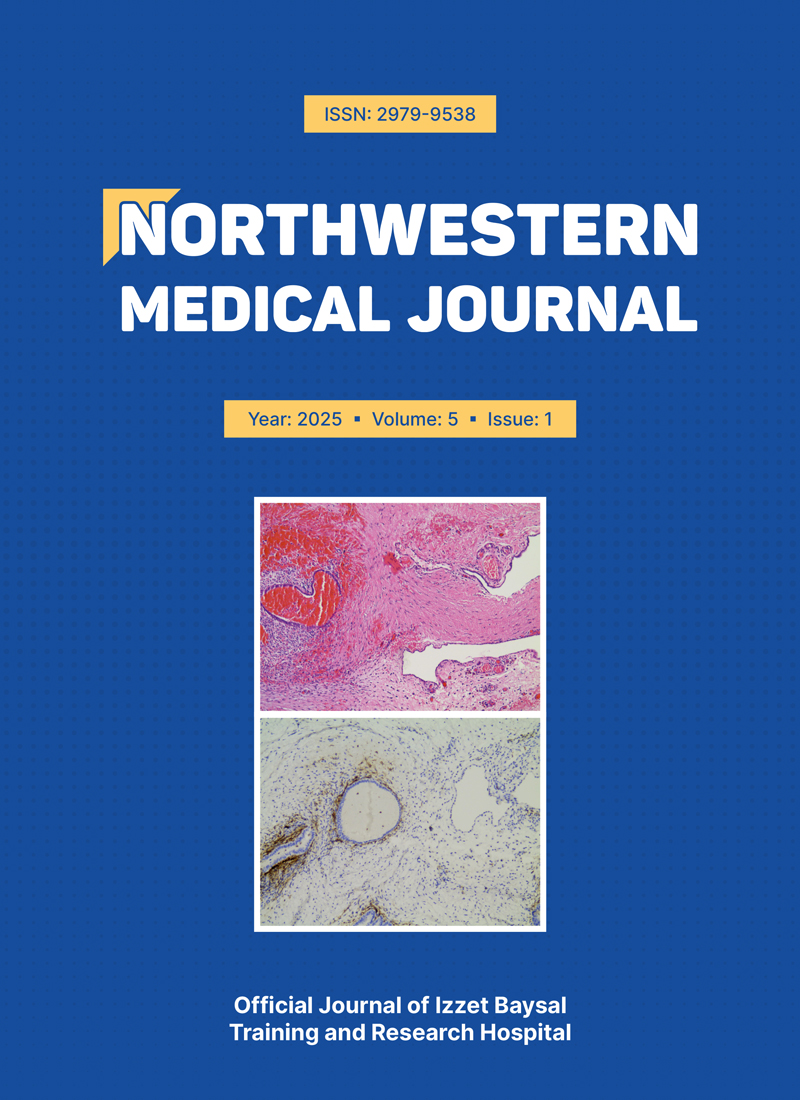Abstract
Desmoid tumors, also known as desmoid-type fibromatosis (DF), develop from musculoaponeurotic tissues. They are Mesenchymal tumorfibrous tumors of benign character that do not metastasize. However, they can take an aggressive course by showing local growth in the area where they are located. Although they can originate fromany skeletal muscle, they are most commonly seen on the anterior abdominal wall. Various treatment options are available depending on the clinical condition of the patient. We aimed to discuss the diagnosis and treatment of DF with a 55-year-old male patient who has DF and applied to our clinic.
Keywords: Mesenchymal tumor, fibrous type, local growth
Copyright and license
Copyright © 2025 The Author(s). This is an open-access article published by Bolu İzzet Baysal Training and Research Hospital under the terms of the Creative Commons Attribution License (CC BY) which permits unrestricted use, distribution, and reproduction in any medium or format, provided the original work is properly cited.
How to cite
References
- Otero S, Moskovic EC, Strauss DC, et al. Desmoid-type fibromatosis. Clin Radiol. 2015; 70(9): 1038-45. https://doi.org/10.1016/j.crad.2015.04.015
- Ganeshan D, Amini B, Nikolaidis P, Assing M, Vikram R. Current update on desmoid fibromatosis. J Comput Assist Tomogr. 2019; 43(1): 29-38. https://doi.org/10.1097/RCT.0000000000000790
- Fiore M, MacNeill A, Gronchi A, Colombo C. Desmoid-type fibromatosis: evolving treatment standards. Surg Oncol Clin N Am. 2016; 25(4): 803-26. https://doi.org/10.1016/j.soc.2016.05.010
- Garcia-Ortega DY, Martín-Tellez KS, Cuellar-Hubbe M, et al. Desmoid-type fibromatosis. Cancers (Basel). 2020; 12(7): 1851. https://doi.org/10.3390/cancers12071851
- Kasper B, Baumgarten C, Garcia J, et al. An update on the management of sporadic desmoid-type fibromatosis: a European Consensus Initiative between Sarcoma PAtients EuroNet (SPAEN) and European Organization for Research and Treatment of Cancer (EORTC)/Soft Tissue and Bone Sarcoma Group (STBSG). Ann Oncol. 2017; 28(10): 2399-408. https://doi.org/10.1093/annonc/mdx323
- Sbaraglia M, Bellan E, Dei Tos AP. The 2020 WHO classification of soft tissue tumours: news and perspectives. Pathologica. 2021; 113(2): 70-84. https://doi.org/10.32074/1591-951X-213
- Yang L, Zhao Y, Luo Q, Jiang H. A giant desmoid-type fibromatosis of the abdominal cavity. Asian J Surg. 2022; 45(12): 2759-60. https://doi.org/10.1016/j.asjsur.2022.06.026
- Lee JC, Curtis D, Williamson JB, Ligato S. Gastric desmoid fibromatosis - report of a rare mimic of gastrointestinal stromal tumor. Cureus. 2021; 13(11): e19614. https://doi.org/10.7759/cureus.19614
- van Maren SA, van Noesel MM, Husson O, van der Graaf WTA. Clinical trials in desmoid-type fibromatosis in children and adults: a systematic review. Pediatr Blood Cancer. 2022; 69(9): e29831. https://doi.org/10.1002/pbc.29831
- Reitamo JJ, Scheinin TM, Häyry P. The desmoid syndrome. New aspects in the cause, pathogenesis and treatment of the desmoid tumor. Am J Surg. 1986; 151(2): 230-7. https://doi.org/10.1016/0002-9610(86)90076-0
- Badak B. Anterior abdominal wall located desmoid type fibromatozis. Osmangazi Journal of Medicine. 2019; 41(4): 425-8. https://doi.org/10.20515/otd.340148
- Grignol VP, Pollock R, Howard JH. Management of desmoids. Surg Clin North Am. 2016; 96(5): 1015-30. https://doi.org/10.1016/j.suc.2016.05.008
- Fiore M, Colombo C, Radaelli S, et al. Hormonal manipulation with toremifene in sporadic desmoid-type fibromatosis. Eur J Cancer. 2015; 51(18): 2800-7. https://doi.org/10.1016/j.ejca.2015.08.026
- Quast DR, Schneider R, Burdzik E, Hoppe S, Möslein G. Long-term outcome of sporadic and FAP-associated desmoid tumors treated with high-dose selective estrogen receptor modulators and sulindac: a single-center long-term observational study in 134 patients. Fam Cancer. 2016; 15(1): 31-40. https://doi.org/10.1007/s10689-015-9830-z
- Bini F, Fiore M, Provenzano S, et al. Management of serious complications in intra-abdominal desmoid-type fibromatosis. Cancer Rep (Hoboken). 2021; 4(6): e1411. https://doi.org/10.1002/cnr2.1411











